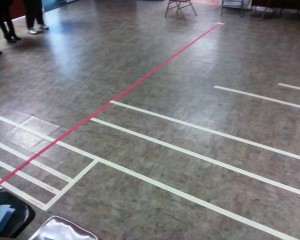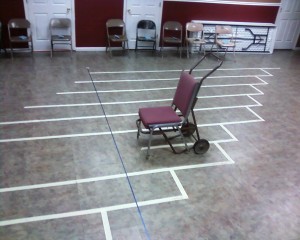For the past several years, Cyndy has been preparing the Sunday School lessons for our church. There are about two dozen children, ages 6 to 12, all in one class. Needless to say, this has been a challenge. Cyndy has been committed to preparing lessons that teach children the stories from scripture, systematically, both Old and New Testament. I think she’s done a marvelous, creative, inventive job. And of course, I’m completely unbiased!
Today’s lesson was from the book of Genesis. During the next 8 week segment, the kids will be going over both the Tower of Babel and the Flood sections, but today was the introductory material. You might not think there would be much for kids in the passages from Genesis 4 & 5 that cover the genealogy of the Patriarchs – but there is! There are ten figures named starting with Adam and ending with Noah. For each one the text gives their age when their son was born and how long they lived. From these figures, it is possible to construct a timeline showing how much time elapsed from Adam to Noah and the Flood.
If we take the year of Adam’s birth as 0 and then add the ages of each Patriarch to the age of their father in the year of their birth we come up with a total of 1,656 years from Adam’s birth to the Flood. But there’s more to think about here than just how much time passed. It’s also intriguing to look at how much the lives of the Patriarch’s overlapped each other. There’s also the fascinating story of Enoch, who did not die, but was taken by God directly into heaven.
To help kids see these relationships, Cyndy planned and laid out a “living timeline” for the kids on the floor of our fellowship hall.
 |
 |
At the start of the lesson, ten children sat in ten chairs and picked up the name of a randomly assigned Patriarch. The teacher called the first name, “Adam.” The student started walking the taped timeline at Adam’s birth, paused when Seth was born, and then continued to walk the rest of the years of their life. Then Seth was called, and so on.
There were two lines drawn across the lifelines of the Patriarchs. A blue ribbon marked the year of Adam’s death. At the conclusion of the class the students were asked, “How many of the other nine Patriarchs could have talked to Adam?” The answer is eight. The tenth Patriarch, Noah, is the first one born after Adam’s death.
When we got to Enoch, by the way, rather than walking to the end of their lifeline, we had one of the teachers wheel the student out in a chair to show that the end of Enoch’s life was different.
The second line drawn across the lifelines was red crepe paper marking the year of the flood. A very concrete illustration of the meaning of Methuselah’s name which is “after me it comes.”
The kids had a good time and the visuals really drove the point home. I was in the sanctuary doing communion at the end of our morning worship service, so I challenged the adults to go find a child from Sunday School and find out how many of the Patriarchs could have talked to Adam.
Here’s what Cyndy wrote the teachers in the teachers’ guide to the lesson:
What we want the kids to take away from all this:
An appreciation for the historicity of Scripture.
Understanding that ALL Scripture, even the “begats” are profitable.
That the genealogies show us that there an eyewitness to Eden was alive for 900 years. This means that Noah could not have talked to Adam about what it was like before the fall, but Noah’s father could have.
One thought on “Teaching Genesis to Children”